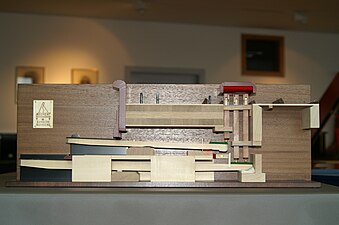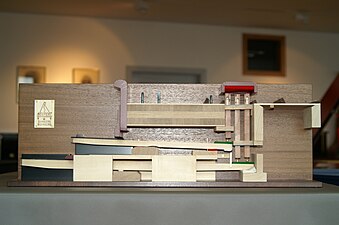Sliding coupling

A sliding coupler is a low-mass , historical coupling device of overlying manual keyboards in historical harpsichord and organ building .
history
With the invention of multiple manual keyboard instruments , it became necessary to build a device that connects the keys of the keyboards, which are located one above the other, in order to be able to play keys of the same type together on one manual. The so-called sliding coupler was invented for this purpose. It was widely used in keyboard instrument making. In this design, a keyboard is pulled a few centimeters towards the player or pushed away from the player, depending on the design, in order to bring about the coupling.
Designs
The sliding coupler is available in two different designs:
Hook coupling
With the hook coupling (also angled hook coupling), L-shaped bent pins on the underside of the upper keyboard engage in metal eyelets, which are attached to the top of the lower keyboard. When paired, the one-armed or two-armed buttons on the lower manual pull the upper buttons with them.
Block coupling
In the case of the Klötzchenkoppel, when coupling one-armed keys, there are blocks on the top of the lower keyboard over the blocks on the underside of the upper keyboard. This means that the lower buttons are pressed together with the upper ones.
As a variant, with two-armed keys, the blocks on the top of the lower keyboard are on the other side of the balance beam over the blocks on the underside of the upper keyboard. The keys of the upper keyboard are also operated via the blocks when playing the lower manual.
disadvantage
- Coupling or uncoupling is only possible during (short) breaks. Depending on the degree of difficulty, both hands are required to operate.
- The system can get stuck if pressed during the game.
- When using the pedal coupler, the coupled keys are usually pulled along with the organ.
Therefore, as a further development, first the fork coupler and later the ram coupler were built, which manage without shifting systems and are therefore generally operated with one hand via a register pull. Today, in the modern organ building in purely mechanical come tracker action solely rocker coupling used. These couplings can be operated without restriction during the game. Sliding couplings are only built again today for historical replicas of instruments.
Individual evidence
- ^ Johann Julius Seidel: The organ and its construction . Volume 2 of Bibliotheca organologica , Edition 2, FA Knuf, 1843, p. 63 ff. ( Google eBook, full view )
- ↑ Winfried Ellerhorst: Manual de organ building customer. Benzinger, Einsiedeln 1936, p. 424 ff.



